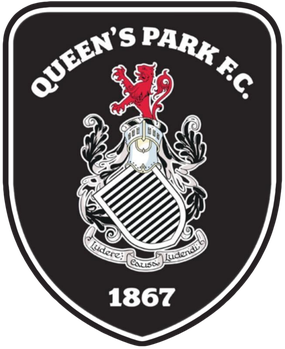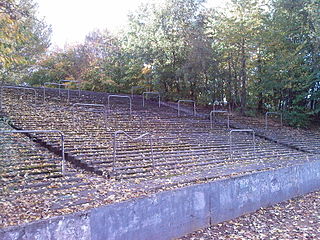
Queen's Park Football Club is a Scottish professional football club based in Glasgow, which plays in the Scottish Championship, the second tier of the Scottish football pyramid. Queen's Park is the oldest association football club in Scotland, having been founded in 1867, and is the 10th oldest in the world.

Hampden Park is a football stadium in the Mount Florida area of Glasgow, Scotland, which is the national stadium of football in Scotland and home of the Scotland national football team. Hampden Park is owned by the Scottish Football Association (SFA), and regularly hosts the latter stages of the Scottish Cup and Scottish League Cup. The largest stadium by capacity when opened in 1903, an accolade the stadium held until 1950, Hampden Park is the 50th largest football stadium in Europe, the 11th largest in the United Kingdom, and the second largest football stadium in Scotland. The stadium retains all attendance records recorded in European football.

Cathkin Park is a municipal park in Glasgow, Scotland. The park is maintained by the city's parks department, and it is a public place where football is still played. The park contains the site of the second Hampden Park, previously home to the football clubs Queen's Park and Third Lanark. The site of the original Hampden Park is just to the west.

Crosshill is an area of Glasgow, Scotland. It is situated south of the River Clyde. It was an independent police burgh from 1871 to 1891 before being annexed by the City of Glasgow.

Hampden Park in Glasgow is the primary home stadium for the Scotland national football team. This has been the case since 1906, soon after it opened. The present site of Hampden Park is the third location to bear that name and both the previous locations also hosted Scotland games. Scotland have also played many of their home games in other stadiums throughout their history, both in friendly matches and for competitive tournaments.
Clydesdale F.C. was a nineteenth-century Glasgow-based football club, which was attached to Clydesdale Cricket Club.

Season 1875–76 was the third season of competitive domestic football in Scotland. It also saw the introduction of the international fixture against Wales. In addition, the first regional competition was introduced, with the first playing of the Edinburgh FA Cup, for clubs in Edinburgh and surrounding areas.

The Scotland national football team represents Scotland in international association football and is controlled by the Scottish Football Association. It is the joint-oldest national football team in the world, alongside England, Scotland's opponents in what is now recognised as the world's first international football match, which took place at Hamilton Crescent in Glasgow in November 1872. Prior to this, a series of matches had been played between teams representing the two countries, but the Scottish team was drawn almost entirely from players based in and around London and these games are now not regarded as full international matches. The lack of involvement by players from Scottish clubs in these matches led to some controversy, which was resolved when The Football Association arranged to send a team to play in Glasgow, where the English players took on a Scotland team composed entirely of players from the Queen's Park club.
Titwood is a cricket ground in the Pollokshields area of Glasgow, Scotland. It is the home of the Clydesdale Cricket Club and is one of four international grounds in Scotland approved by the International Cricket Council (ICC) as a home venue for the Scotland national cricket team.
The 1873–74 Scottish Cup – officially the Scottish Football Association Challenge Cup – was the first season of Scotland's most prestigious football knockout competition. A total of 16 teams from the west of Scotland entered the competition, but only 14 played a match after two teams withdrew. The competition began with a match between Renton and Kilmarnock on 18 October 1873 and concluded with the final on 21 March 1874. After 16 matches and 38 goals, the inaugural cup was won by Queen's Park who defeated fellow Glasgow club Clydesdale 2–0 in the final.

The 1874–75 Scottish Cup – officially the Scottish Football Association Challenge Cup – was the second edition of Scotland's most prestigious football knockout competition. Teams from Edinburgh, Renfrewshire and Lanarkshire entered the competition for the first time and with 12 new teams entering the competition, a total of 25 were included in the first round draw. The competition began with the first round match between Rangers and Oxford on 10 October 1874 and concluded with the final on 10 April 1875. After 27 matches and 56 goals scored, defending champions Queen's Park retained the trophy by defeating Dunbartonshire club Renton 3–0 at the original Hampden Park in the final.
The 1874 Scottish Cup final was the inaugural final of the Scottish Cup and the final of the 1873–74 Scottish Cup, the most prestigious knockout football competition in Scotland. The match took place at Hampden Park on 21 March 1874 and was contested by Queen's Park and Clydesdale.
The 1875 Scottish Cup final was the second final of the Scottish Cup and the final of the 1874–75 Scottish Cup, the most prestigious knockout football competition in Scotland. The match took place at Hampden Park on 10 April 1875 and was contested by Queen's Park and Renton.
The 1876 Scottish Cup final was the third final of the Scottish Cup and the final of the 1875–76 Scottish Cup, the most prestigious knockout football competition in Scotland. The original match took place at Hamilton Crescent on 11 March 1876 and was contested by Queen's Park and 3rd Lanarkshire Rifle Volunteers. The match was the first final to be held at a neutral venue and also the first to require a replay to decide a winner.
The 1883 Scottish Cup final was the 10th final of the Scottish Cup and the final of the 1882–83 Scottish Cup, the most prestigious knockout football competition in Scotland. The original match - which ended in a 2–2 draw - was played at Hampden Park in Crosshill on 31 March 1883 and was watched by a crowd of 15,000 spectators. For the first time in the competition's history, the final was contested by two teams from outside Glasgow - Dumbarton, who had never won the cup before, and three-time winners Vale of Leven.
Pollokshields Athletic F.C. was a Scottish football team, based in the Pollokshields district of Glasgow.
Ibrox Park was a football ground in Ibrox, Scotland. It was the home ground of Rangers from 1887 until they moved to the adjacent second Ibrox in 1899. The ground staged the Scottish Cup Final four times and also three Scotland international matches.
South Western Football Club was a Scottish football club active in the 19th century.
Kinning Park was a 19th-century sports ground in Kinning Park, Renfrewshire, Scotland, primarily used for cricket and football. It was the home of Clydesdale Cricket Club from 1849, staging a number of important matches against visiting English teams. It was also the original home of the club's football team, Clydesdale F.C. When both teams relocated to Titwood in 1876, Kinning Park was taken over by Rangers F.C., who played there until moving to the first Ibrox Park in 1887. The ground was the venue for the 1881 Scottish Cup Final between Queen's Park and Dumbarton.









